Kozono Takaaki, Part-time Employee Waseda University History Museum
On September 1, 1923 (Taisho 12), a massive earthquake measuring 7.9 on the Richter scale occurred in southern Kanto. This was the Great Kanto Earthquake. The death toll was estimated to be approximately 105,000, mainly in Tokyo and Yokohama.
The state of Waseda University at the time of the earthquake is described in the third volume of the "早稲田大学百年史“(A Hundred-year History of Waseda University) as follows: President Takada Sanae, Professor Emeritus Tsubouchi Shoyo, and Director Emeritus Ichishima Kenkichi were sitting down to lunch after discussing commemorative projects at Okuma Kaikan when the big earthquake hit. The entire hall apparently shook like a big wave. Damage to buildings on campus included two completely destroyed, one partially destroyed, one damaged, and one burned down. 5 students died and 806 were injured and 32 faculty and staff members were injured and, none died.
Left photo: The collapsed auditorium (near the current Waseda Campus Building 8). This is different from the current Okuma Auditorium. For more details, click here(Japanese only) (Waseda University Photo Database, original photo, B065-14)
Photo on the right: Burnt remains of the Applied Chemistry Laboratory (near current Building 6 on Waseda Campus) (Waseda University Photo Database, original photo, B118-06)
Waseda University, which suffered less damage than the epicenter of the disaster in Tokyo (Nihonbashi, Kyobashi, etc.), was tasked with accommodating and providing relief to evacuees. The combined Waseda Gakuho issue 343/344 states that "as many school buildings as possible were opened to accommodate evacuees," and according to the “大正大震火災誌”(Taisho Great Earthquake and Fire Journal) compiled by the Metropolitan Police Department, 721 evacuees were accommodated.
The damage caused by the Great Kanto Earthquake was not limited to the collapse of houses and fires. After the earthquake, Koreans were massacred all over the Kanto region by military and vigilante groups who believed the false rumors of Korean riots, and thousands of people were killed. What about the area around Waseda University?
Waseda University's response to the false rumor of Korean riots
The aforementioned "大正大震火災誌“(Taisho Great Earthquake Fire Journal) states that "rumors of arson by Senjin (*1) began to spread" in Totsuka-cho before dawn on September 2nd, and by the 3rd, "rumors of violence by Senjin became more prevalent, eventually prompting the emergence of vigilante groups that roamed the streets carrying weapons (swords, guns, and other weapons)." Rumors of arson and violence by Koreans also spread around the university, and vigilante groups were formed in the town.
(※1) This is a term used to refer to Koreans and is now considered discriminatory, but as a historical reference we will leave the original text as is. Same below.
The journal of the General Affairs Division at the time of the earthquake, held in the Higashifushimi Archives of the History Museum, is a valuable document that conveys the situation at the university in real time. On September 2nd, it reads, "There are plans to set fires and poison wells, so everyone is cooperating tonight and taking precautions (on campus)." The aforementioned Waseda Gakuho also states, "Rumors that Koreans had set fires or dropped bombs threatened the Yamanote area," and "staff members worked tirelessly day and night to keep guard, without regard for the safety of their own homes." Thus, rumors about Korean riots (arson, poisoning wells, dropping bombs) were circulating at the university, and staff members were on guard.
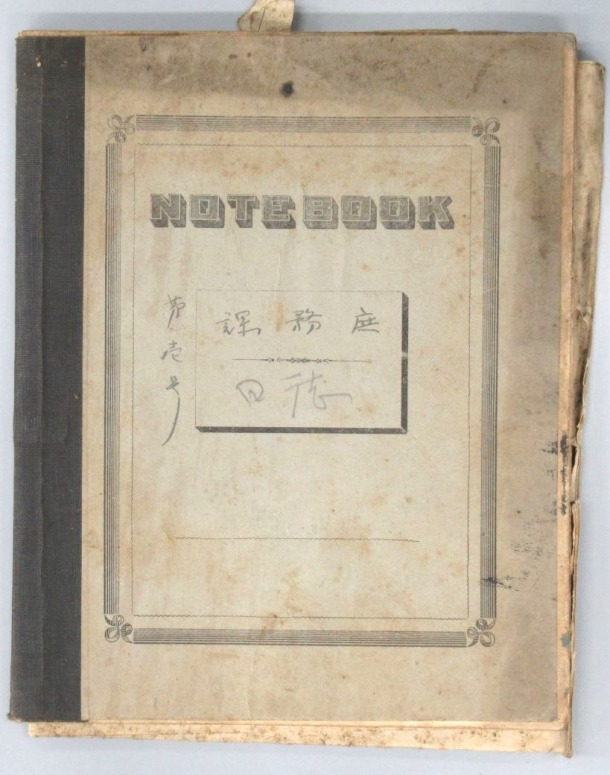
The General Affairs Division's journal from the time of the earthquake (Document 58-04, formerly held in Building 3). On September 3rd, it is recorded that the university asked the Chohaku dormitory to shelter Koreans who were working at a factory in Shitaya.
Also, the following is an excerpt from September 5th from the journal of the General Affairs division "長白寮ニ立籠レル鮮人学生四十数名、食料ニ窮スルノ余リ自 ラ其建物ニ火ヲ発シ、其ノ混雑ニマギレ逃走スベシナ ドノ流言アリ、同寮ヲ囲ミ警戒セル騎兵警護者之乱レ タルニ、或ハ左モ見ラレルモ、吾々ハ左様思ハズトノ 事ナリキ". The "騎兵警護者 cavalry guards" mentioned here are thought to be the Toyama Imperial Cavalry Regiment. The quote says the regiment surrounded the dormitory, believing the rumor that the Korean students in the Chohaku dormitory were setting fire to the building and fleeing due to a lack of food, but the university administration did not believe them, saying, "左様思ハズ They would never have thought the students would do this."
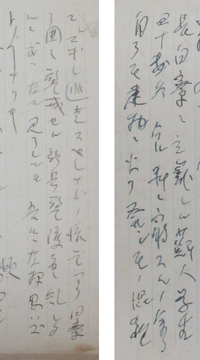
Excerpt from the General Affairs Division's journal for September 5th (Formerly held materials 58-04 Building No. 3)
According to the "Situation of Koreans in Tokyo" compiled by the Government-General of Korea (※2) the year after the earthquake, this Chohaku dormitory was also known as "Shinsai-an" and its address was "655 Shimo Totsuka." This dormitory housed many struggling Korean students and was managed by "Ito Nanao." What kind of person was he?
(*2) The Japanese governing body of Korea that was established in Korea from the annexation of Korea in 1910 until 1945.
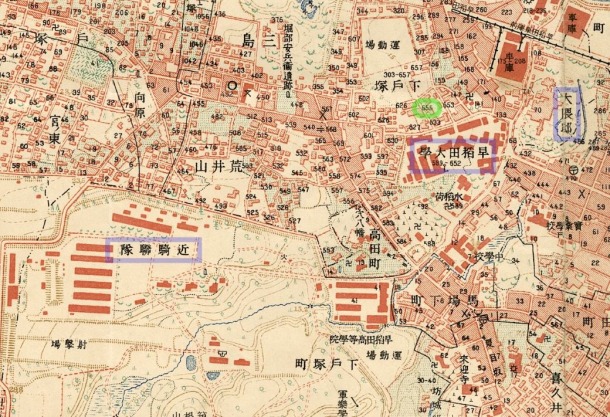
A 1923 map (Waseda Area Map Reference 18). The Chohaku dormitory is circled in green on this map and is located near the current Building 14 on Waseda Campus (Click to enlarge.)
Ito Nanao, who saved the Korean student
In research on Miyazawa Kenji, Ito's name often appears due to his friendship with the author. For example, the 16th volume (lower) of the "新校本宮澤賢治全集”(New Revised Edition of the Complete Works of Miyazawa Kenji) states that Ito was from Mizusawa, Isawa, Iwate Prefecture, and belonged to the Japan Labor-Farmer Party. In addition, in the 1931 works "自治団体之沿革“ (History of Autonomous Organizations) and "水沢町史”(History of Mizusawa Town) it is confirmed that Ito studied at Waseda University, and in the latter it is confirmed that he graduated from the "Department of Political Science and Economics at Waseda University."
There is also a passage about Ito in "菩薩行のひと”(Bodhisattva's Way) by Mori Soichi, a writer who was also friends with Miyazawa Kenji, in which he writes that during the Great Kanto Earthquake, "he protected over twenty Korean students at Chohaku dormitory without a single casualty." Ito was 24 years old at the time. "震災美談“(The Beautiful Story of the Earthquake) published one year after the disaster, states the following:
"He had a deep understanding and sympathy for Koreans and had previously operated a dormitory for struggling Korean students called Shinsai-an, providing convenience to Korean students directly and indirectly. After the earthquake on September 1st, the Koreans in the area were unable to buy food and other necessities or save any money as struggling students. They were also misunderstood by the general townspeople and excluded from distribution and did not receive support. On top of that, they were oppressed by vigilante groups and were in dire straits. However, Ito negotiated with the branch office of the Government-General of Korea and the Tokyo Prefectural Government, and obtained food rations for 54 Korean students, including Lee Il-sang, who were boarding at Shinsai-an, and made great efforts to protect and provide relief to them."
As mentioned above, Ito protected Korean students at Chohaku dormitory, but "震災美談“(The Beautiful Story of the Earthquake) are heroic tales collected in order to promote "Japanese-Korean reconciliation (*3)." We must not forget that there was a dynamic at work that attempted to erase the issue of the massacre of Koreans, which resulted in so many casualties, through heroic tales, and that many such stories began to be told after the earthquake. In the November 15, 1923 edition of the Waseda University Newspaper, a Korean student who experienced the earthquake was quoted as saying, "We have learned a very good lesson: the Japanese people are not a nation that can ever assimilate with the Korean race."
(※3) This slogan was used as part of the assimilation policy during the colonial rule of Korea, with the aim of easing ethnic conflict between Japan and Korea.
According to the aforementioned "新校本宮澤賢治全集“(New Revised Edition of the Complete Works of Miyazawa Kenji) after the earthquake, Ito traveled to Germany, but "fell ill with chest pains while studying abroad, so he bought land on Oshima and built a house there to recuperate around the end of the Taisho era or the beginning of the Showa era." In April 1931 (Showa 6), he established the Oshima Agricultural School, but he died on August 13 of the same year (aged 32), and the school was closed the following January. Also, according to the March 22, 1925 edition of the ”東亜日報“(East Asia Daily), Chohaku Dormitory was suddenly abolished by the Government-General of Korea in the same year.
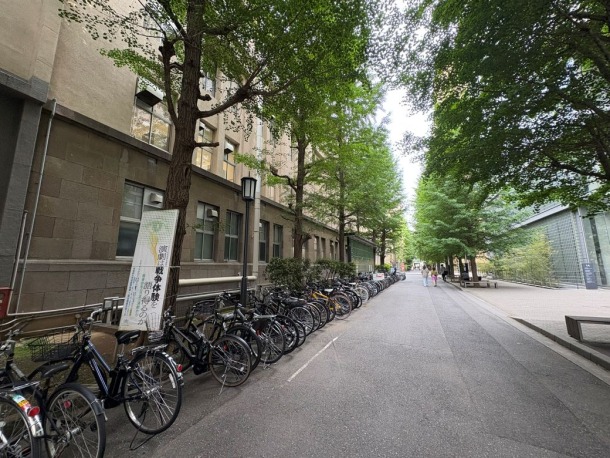
Current view of where the Chohaku dormitory once stood (near Building 14, Waseda Campus)
[References]
早稲田大学校友会『早稲田学報』第343・344合併号(早稲田大学校友会、1923年10月)
1923年11月15日『早稲田大学新聞』
中島司『震災美談』(中島司、1924年)
1925年3月22日『東亜日報』
警視庁編『大正大震火災誌』(警視庁、1925年)
篠田雀『自治団体之沿革』(東京都民新聞社、1931年)
後藤廣『水沢町誌』(岩手県胆沢郡水沢町役場、1931年)
森荘已池『菩薩行のひと』(自然療養社、1948年)
早稲田大学大学史編纂所『早稲田大学百年史』第三巻(早稲田大学、1987年)
宮沢清六ほか編『新校本宮澤賢治全集』第16巻(下)(筑摩書房、2001年)
姜徳相『関東大震災・虐殺の記憶』(青丘文化社、2003年)
裵姈美編『在日朝鮮人留学生資料』1~3(緑蔭書房、2012年)
早稲田大学百五十年史編纂委員会『早稲田大学百五十年史』第一巻(早稲田大学、2022年)
*For materials held by the History Museum, the Waseda University Photo Database, materials formerly held in Building 3, and maps of the Waseda area were used.
Kozono Takaaki / Part-time contract staff member Waseda University History Museum
He completed his doctoral Graduate School of Letters, Arts and Sciences at Senshu University, receiving his PhD in History. He is also a curator at the Tokyo Air Raid and War Damage Materials Center and a part-time lecturer at Waseda University and other institutions. He specializes in the Great Kanto Earthquake, the Tokyo Air Raid, and peace education. His publications include "Photo Collection of the Great Kanto Earthquake" (Nishi Nippon Shuppansha, 2023) and "Questioning the Present 100 Years After the Great Kanto Earthquake" (Nihon Keizai Hyoronsha, 2024), among others.

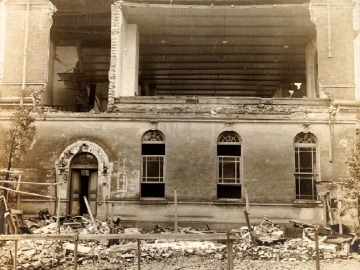
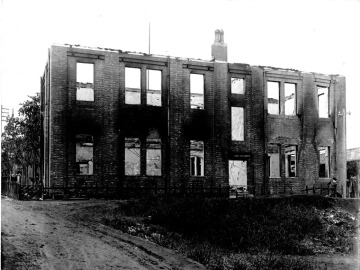

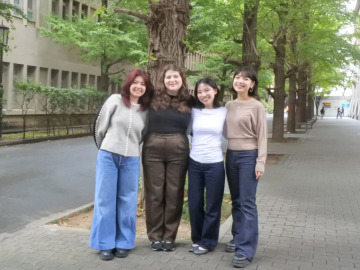
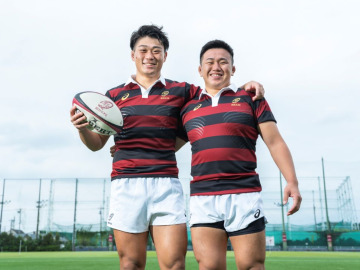
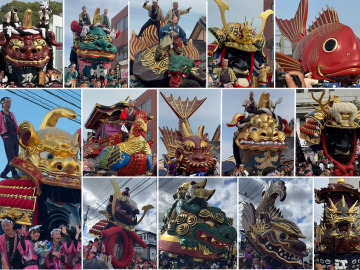

![[Save version] Map of the four main campuses](https://www.waseda.jp/inst/weekly/assets/uploads/2025/09/17cb2975123fc5103172ef60bd98608d-610x458.jpg)

